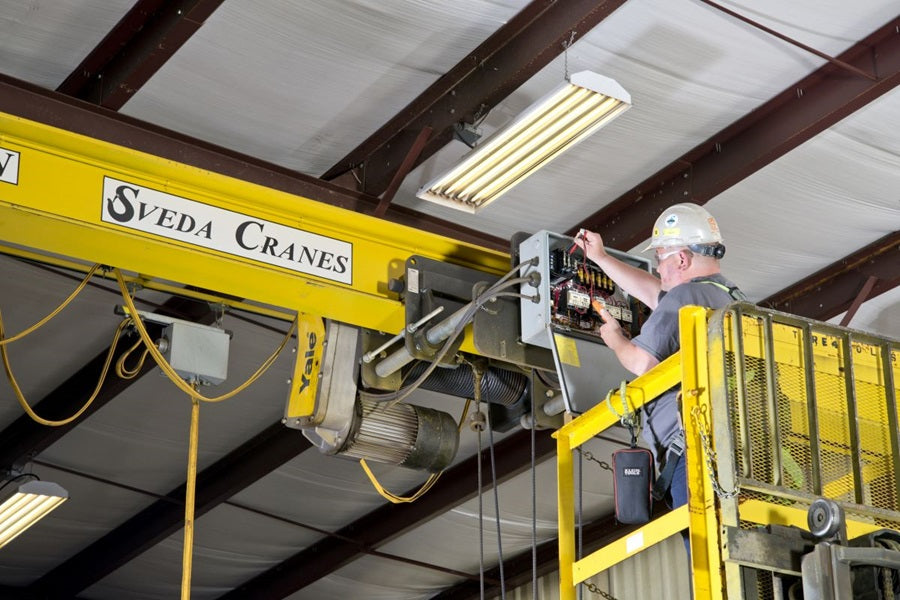
How often Should my Overhead Crane be Inspected?
Shupper-Brickle Equipment Co
For this Hoist Guy’s Blog, guest blogger Daniel P. Cahill, Service & Operations Manager for Shupper-Brickle Equipment, shares his experience and advice on the frequency of crane inspections and why inspections are critical to the workplace.
Overhead Bridge Crane Inspections
Inspections are a critical component in achieving the highest degree of efficient production, limiting down time, and maintaining a safe work environment. But customers often ask: How often should I schedule inspections for my overhead crane? And while bridge cranes should be inspected routinely by the operator, there are a number of factors that can be used to help you determine how often to have your crane fully inspected by a professional Crane Inspector. Meanwhile, it’s helpful to know how crane inspections are classified, and why they’re important.
Determining Factors for Crane Inspection Frequency
The frequency of overhead crane inspections is determined by factors such as the operating environment, the application and frequency of use. Cranes that are used more frequently or in harsher environments will require more frequent inspections.
Operating Environment
The conditions in which the crane operates will affect how often it must be inspected. Operating environments can be categorized as either:
- Harsh environment: outdoors, marine environment, chemical environment, dusty environment
- Normal environment: temperature-controlled plant or building
Overhead bridge cranes operating in harsh environments will require more frequent inspections than cranes operating in a normal environment.
Application
What the crane is used for, or the lifting application, will also affect how often it should be inspected. Applications can be categorized as:
- Severe: concrete plant, chemical plant, foundry, nuclear plant
- Heavy: fabrication or production
- Normal: stand by – maintenance
Overhead bridge cranes that are used for severe applications will require more frequent inspections than a heavy-duty fabrication or production crane. Normal-duty cranes can go even longer between inspections.
Frequency of Use
How often the crane is used is another factor that will determine the frequency of inspections. Frequency of use can be categorized by:
- Infrequent or standby – idle most of the time, used for maintenance
- Light – fabrication or light maintenance
- Standard – production, 25% of working period
- Heavy – high volume, heavy production, 50% of working period
- Severe – frequent or continuous, 75% - 100% of working period
The more often the crane is used, the more often it will need to be inspected.
Crane Inspection Classification
OSHA has four main crane inspection classifications: initial, functional test, frequent and periodic inspections.
Initial Inspection
This inspection takes place prior to initial use of any and all new, altered, or modified cranes / hoists.
Functional Test Inspection
This is a daily visual inspection of all functional operating mechanisms that should be performed before every shift.
Frequent Inspection
These inspections take place at frequent intervals depending on the crane’s service type. They include inspecting the operating mechanisms, hooks, and hoist chains to maintain proper use.
- Normal service cranes should be inspected monthly
- Heavy service cranes should be inspected weekly to monthly
- Severe service cranes should be inspected daily to weekly
Periodic Inspection
Periodic inspections are complete inspections of the entire overhead crane system by a qualified inspector. The frequency is determined by the crane’s service type.
- Normal service cranes should be inspected yearly
- Heavy service cranes should be inspected semiannually
- Severe service cranes should be inspected quarterly
What is a good crane inspector checking or looking for?
A good crane inspector will look for signs of excessive wear and damage including cracks, and deformations as well as loose bolts, corrosion and leaks. They will perform both a visual and operational inspection checking for:
- Electrical Hazards
- Mechanical Hazards
- Functional Hazards
- OSHA / ANSI Compliance
What does a professional crane expert see that even a routine user might miss?
A professional crane inspector is likely to see things that the everyday operator may miss. Not only are they a fresh set of eyes, but their extensive experience and knowledge of overhead cranes allows them to easily spot and correct many issues including:
- Proper Brake Adjustment
- Gear Alignment
- Worn Load Chain or Wire Rope
- Worn Hook / Sheaves
- Worn Wheels
- Worn Bearings
- Improper Wiring / Noncompliant Wiring
- Compliance to OSHA / ANSI Standards
Inspection Service for Hoists & Overhead Cranes
Shupper-Brickle provides hoist and overhead crane inspections that satisfy OSHA requirements throughout the Mid-Atlantic States, including New Jersey, the Greater NYC area, the Greater Philly area, Delaware and Eastern Shore Maryland. Our factory-trained inspectors will perform a comprehensive analysis of your material handling equipment and provide inspection frequency recommendations.
Our hoist and overhead crane inspection services include:
- OSHA Crane & Hoist Inspections
- Preventative Maintenance Plans
- Same-Day Rigging Inspections
- Fall Arrest Inspections
- Fixed Ladder Inspections
Call Shupper-Brickle’s Crane & Hoist Inspection Service Department at 800-64CRANE or or contact us through this website to schedule a hoist and crane inspection today. The operating environment, application, and frequency of use will dictate how often inspections should be performed.


